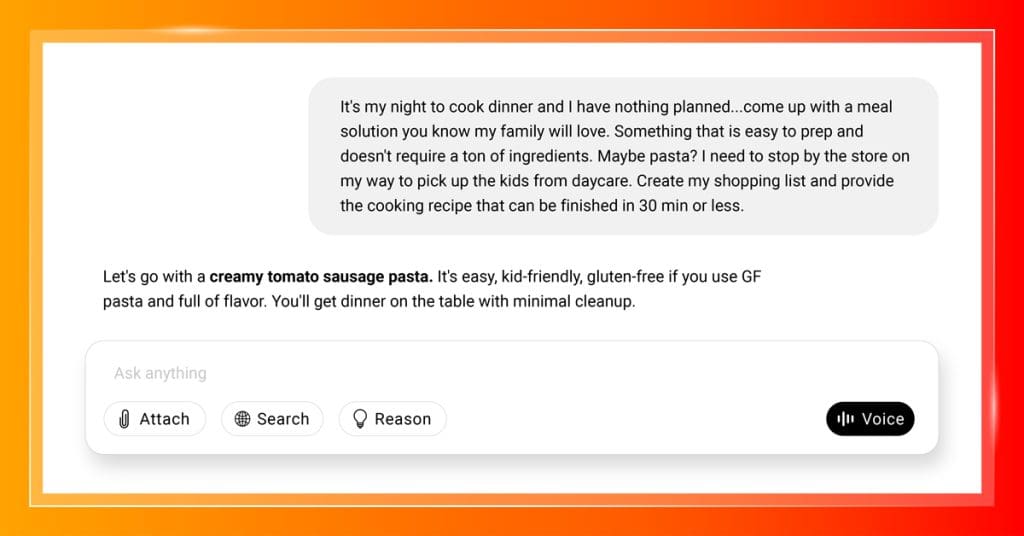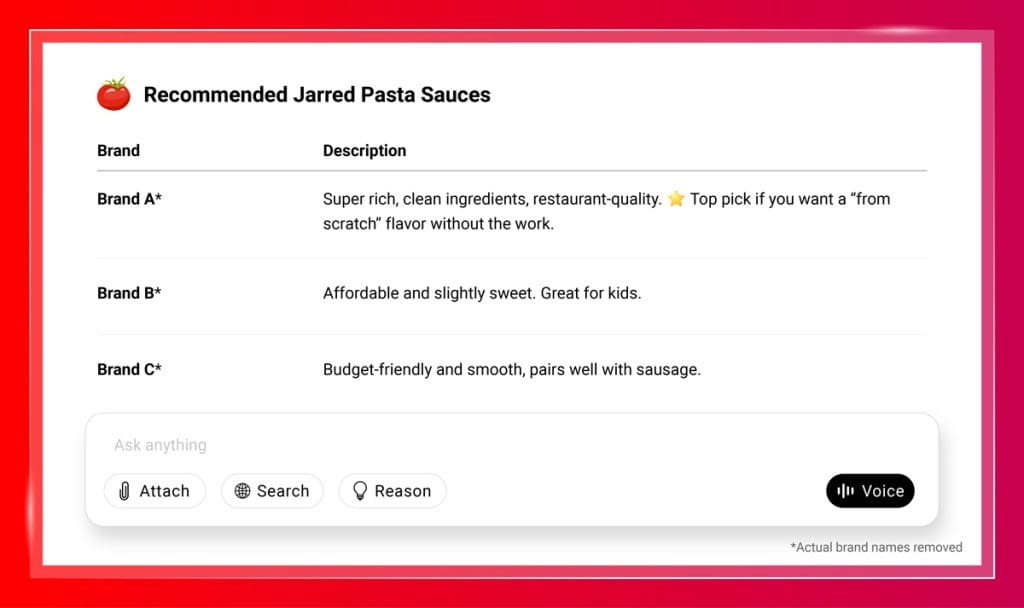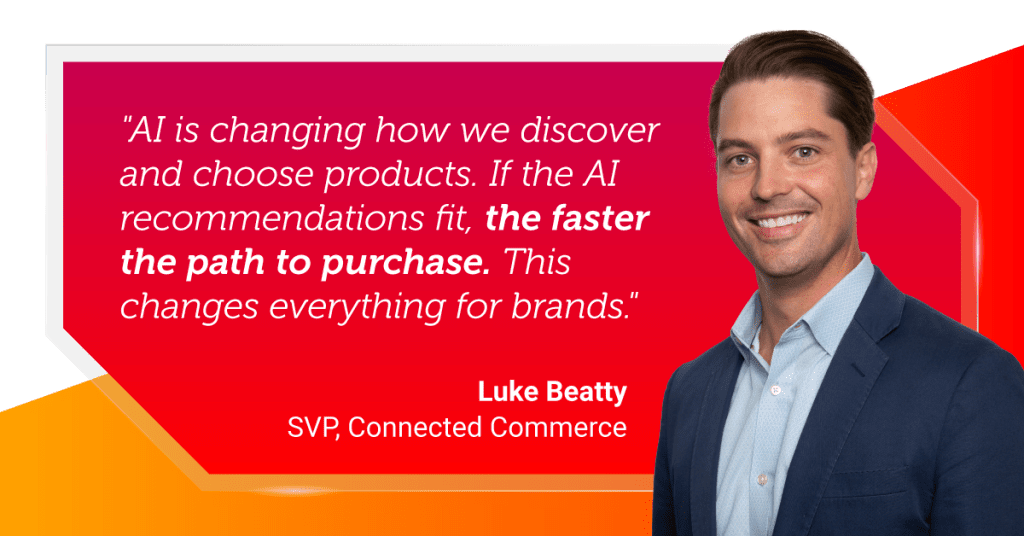ChatGPT Picks Favorites. Is Your Brand One of Them?

By Luke Beatty, SVP, Connected Commerce, Acosta Group
As I was wrapping up a conference call and heading out to pick up my kids from daycare, I realized: #%*&! It’s Tuesday and I’m in charge of dinner tonight. My wife will kill me if I default to another Taco Tuesday.
I quickly popped open ChatGPT for the save:

It came back with a foolproof recipe and detailed shopping list, including visuals and where to find each item at Kroger. It remembered my wife’s gluten allergy and that my kids prefer “the red sauce.” It also assumed I wouldn’t have time (or was too lazy) to create my own sauce from scratch.
What surprised me was that it listed only three brands of marinara — and one stood out instantly thanks to its glowing description.

It was a sharp reminder: AI isn’t just helping us shop. It’s deciding what lands in the cart.
Why This Matters for Brands
Search as we know it is moving fast. Tools like ChatGPT and Google’s new AI Mode are reshaping how we discover and choose products. Instead of googling “best pasta for kids” and sifting through ads and blogs, we’re getting curated, human-like answers based on what we’ve shared and what AI can pull from across the web. If your product isn’t part of the answer, it’s out of the running.
According to Acosta Group Shopper Insights research, generative AI is already outpacing smart wearables and smart home devices in adoption:
- 70% of shoppers have used one or more AI tools to help them shop, experimenting with ways to save money and time.
- Less than 15% of shoppers are using retailer AI shopping assistants today, though adoption is expected to rise as awareness and integrations improve.
- 89% of shoppers trust generative AI as much—or more—than other information sources.
- Only 12% say they trust it less, preferring traditional search.
That shift rewrites the playbook for brands.
To stay in the conversation, here are three things to keep in mind:
Big Idea 1: AI Gets Personal (Fast)
The more context people share (family size, allergies, budgets, ingredient preferences, favorite retailers), the more relevant AI results become. Getting found today depends on a broader, more nuanced set of signals. Product detail pages (PDPs), reviews, third-party mentions, and even Reddit threads feed into what AI “sees.”
It doesn’t just scan the site; it reads the room.
This kind of relevance is already changing how people shop — from what goes in their cart to how they update their wardrobe. Google’s new agentic shopping feature will let users set their ideal size, color, and price, then sit back while AI tracks the product and completes the purchase for them. When the moment is right, a prompt appears to confirm — and Google Pay takes care of the rest.
When a recommendation feels spot-on, shoppers are more likely to click “buy.” Add a direct retailer link, and you’ve made it easy to act in the moment.
Big Idea 2: Sponsored Search is Evolving
This isn’t traditional search. You can’t just pay your way into the answer box. Large language models (LLMs) prioritize sources that are credible, consistent, and up to date.
If your PDP says one thing, reviews say another, and media coverage is sparse or outdated, AI will skip over you. Your brand story must be both complete and easy for machines (and people) to understand.
And when it comes down to two or three similar options, your edge (sustainability, flavor, price, or speed) may be what tips the scale.
That said, paid placements are coming. EMARKETER projects that AI search advertising could hit $25 billion by 2029. Retail media networks are already testing new ways to blend paid and organic results. Ads within Copilot, Microsoft’s LLM, have 73% higher click-through rates and 16% stronger conversion rates compared to traditional search. But even when ads arrive, strong signals and clear content will still matter most.
Big Idea 3: It’s Time to Get AI-Ready
Forward-thinking companies are already adapting:
- Walmart’s Sparky assistant compares products, summarizes reviews, and remembers preferences. The retailer’s partnership with OpenAI will allow customers and members to complete Walmart purchases directly within ChatGPT.
- Shopify is also integrating with ChatGPT for seamless chat-to-checkout experiences.
- Visa is redesigning its data architecture to support conversational commerce.
- Instacart launched Ask Instacart, turning natural questions into product suggestions.
As one analyst put it, “Google just nuked the funnel.” Google Search’s AI Mode surfaces AI-generated overviews before traditional links. Product discovery is happening faster and earlier — and AI is the new gatekeeper.
“Brands that win won’t treat AI like a channel. They’ll treat it as the new shelf. They’re cleaning up content, aligning product data, and paying close attention to what’s being said out in the wild.”
What You Can Do Today
Building the right foundation now can help your brand stay visible as AI reshapes the shopping journey. You don’t need perfection. But you do need a plan. Here are five smart moves to make now:
1. Strengthen your PDPs
Use common keywords, complete your attributes, and add high-quality visuals. Make sure your listings feed into retailer APIs and search integrations. Include shopper moments (like birthdays, pool parties, or game nights) in your descriptions, bullets, and metadata fields. Focusing on digital commerce fundamentals will help you win now and in the long run.
2. Prep for paid AI placement
AI tools that support ads are on the way. Be ready with ad strategies built for zero-click shopping. Walmart, for example, is using generative AI to build homepages that reflect each shopper’s preferences, making it feel more like a store designed just for them. This indicates that the tipping point is near or has been reached. And as AI advertising grows, strong content and attribution will still drive visibility.
3. Syndicate structured product data
Tools like Salsify, Syndigo, and 1WorldSync help push clean, consistent data across your retail partners. One expert calls them “the plumbing behind agentic commerce.” Without them, your product may be invisible to AI.
4. Name products like people talk
If your listing says “GF bread flakes” but shoppers are searching “gluten-free panko crumbs,” you’re missing out. Amazon’s AI assistant Rufus thrives on real language, and the company is rolling out two-part product titles (a clean name plus highlights) to help.
5. Test how AI agents recommend
Run common shopper questions and prompts in ChatGPT, Walmart’s Sparky, Amazon’s Rufus, Copilot, Perplexity, and Google Gemini. Who shows up? Are you there? Use those answers to tweak your content for conversational search and stay competitive.

The New Shopping Journey
The funnel is shrinking as AI moves shoppers from curiosity to checkout in record time.
Whether they’re using voice assistants, in-app helpers, or new search tools, shoppers are already saying things like “Restock my taco night staples.” And if AI can’t confidently recommend your brand, you’re not getting in the cart.
We helped one brand become truly shopper-ready at Target, aligning its content, ad strategy, and search visibility. That kind of alignment is what AI rewards.
We’ll keep tracking what’s changing — so your brand is always ready to show up and stand out.
Want help figuring it out?
Our Connected Commerce experts can get your brand AI-ready.







